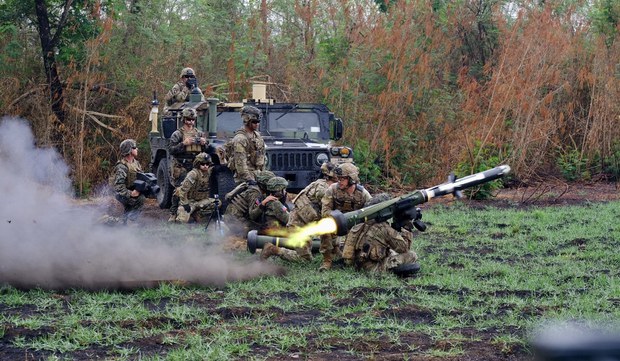US missile launcher deployed to Philippines ‘defensive in nature’
2024.04.25
Manila
 U.S. and Philippine soldiers fire Javelin shoulder-launched anti-tank missiles during exercises at Fort Magsaysay, Nueva Ecija province, northern Philippines, April 13, 2023.
U.S. and Philippine soldiers fire Javelin shoulder-launched anti-tank missiles during exercises at Fort Magsaysay, Nueva Ecija province, northern Philippines, April 13, 2023.
The U.S. Army’s deployment of a mid-range missile launcher in the Philippines this month is defensive in nature and temporary, according to an American general in the Southeast Asian nation for joint military exercises.
The Mid-Range Capability (MRC) missile system – also known as the Typhon System – has been positioned on the northern island of Luzon for this year’s “Balikatan” exercise that involves more than 16,000 troops and an array of major military hardware.
China has protested the deployment of the missile launcher, accusing Manila and Washington of aggravating tensions that have flared recently over territorial claims in the South China Sea.
“We are not looking for a fight. Everything we do is defensive in nature,” Lt. Gen. Michael Cederholm, commander of the U.S. 1st Marine Expeditionary Force, told reporters Wednesday when asked about the Chinese remarks.
Cederholm would not say how long the MRC system would stay in the country, but he assured the public its deployment was only for America’s Filipino allies to learn how to use it.
“I think it's pretty straight forward that we are bringing a defensive capability that is fairly new and we are figuring out how to interoperate [while] moving around in various spots that we are going to deploy it,” he said.
“It’s a defensive posture. When we are done training with it, we will bring it back home and continue to develop our tactics, techniques, procedures,” he said.
The Typhon System can fire the Standard Missile 6 (SM-6) and Tomahawk missiles and support strike capabilities from land, sea and air.
It was designed for extended-range anti-air warfare against ballistic missiles, with an operational range of more than 240 km (150 miles) and an active radar homing guidance system that allows the projectile to find and track its target autonomously.

The Balikatan (shoulder-to-shoulder) drills started Monday and involve 11,000 troops from the U.S. and 5,000 from the Philippine side, along with hundreds from Australia and France.
This year, the Americans have dedicated ships, aircraft including their F-22 Raptor fighter jets, and medium-range capability weapons system, among others, for the exercise.
The Philippine military will be showcasing some of the military hardware it acquired for its modernization program, including a frigate, FA-50 fighter jets, and Super Tucano light attack aircraft.
As part of the exercise, maritime drills between France, the U.S. and the Philippines are scheduled from April 25 until May 4. For the first time, a joint sail will take place outside the Philippines’ territorial waters – beyond the 12 nautical-mile mark, but within the exclusive economic zone.
The main event will be a ship sinking exercise in which participants will have to test the interoperability of their weapons systems to strike a mock enemy ship, the Chinese-made BRP Lake Caliraya (AF-81), off the coast of Laoag in Ilocos Norte on May 8.
Col. Michael Logico, the Philippine Balikatan spokesman, said the vessel was chosen because it was the right size for the exercise and the military did not know it was made in China.
Beijing has criticized the annual drills, saying they are provocative and that its position on the South China Sea remained clear.
Beijing claims nearly all of the disputed waterway and dismisses overlapping claims from the Philippines, Malaysia, Brunei, Vietnam and Taiwan.
Earlier this week, the Philippine Navy reported an increase in the number of Chinese maritime militia vessels in the South China Sea, coinciding with the start of the joint military exercises.
Don McLain Gill, a geopolitical analyst at De La Salle University’s international studies department in Manila, said the message behind the drills was “very clear.”
“Given what is happening today in the West Philippine Sea where China is pursuing the expansion of its forces, this actually adds more significance to the Balikatan,” he said.
“The Marcos administration cites what is taking place in the West Philippine Sea should be in the interest of the Filipino people and Philippine national interest,” he said.
The 39th edition of the annual exercise is being carried out under the two countries’ 1951 Mutual Defense Treaty that calls on both countries to aid each other in times of aggression by an external power.
Jason Gutierrez, Jeoffrey Maitem and Mark Navales reported from Manila







